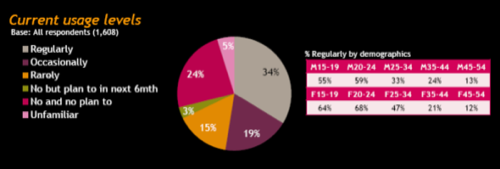We all know by now that social networks aren’t a passing fad. They’re no longer used solely by early adopters, young adults, or tech enthusiasts – social networks are now mainstream. However, a recent UK study conducted by media research company, Entertainment Media Research, reports some figures that point toward the fact that social networks could do even more. In fact, social networks have the potential to be the content distribution platforms of tomorrow. See you later iTunes, I’m gonna sync with MySpace now…

The January 2008 findings come out of a large, 249-page survey, where 1600 UK consumers were polled on everything from behavior, to trends, preferences and attitudes to all forms digital entertainment across the board.
Although the poll features UK users only, it’s easy to extrapolate some commonalities from the answers they provided. UK users are a subset of networks in question, but just as digitally invested in their social connections as any other demographic of users.
Who’s Online and What Are They Doing?
The survey shows the top five UK social networks to be, in order, Facebook MySpace, Friends Reunited, YouTube, and Bebo. MSN Spaces falls just behind Bebo, if you’re not one to count YouTube as a social network as they do because of its community element.
In the UK, social network usage does correlate with age, but even 1 in 8 of 45-54 year olds regularly use them, as do half of teenage males and two thirds of teenage females. Looking at the younger demographic (under 25 years old), 60% are using social networks.
Usage levels

This gain in popularity comes from the expense of other activities and media. The main activities showing a decline in time spent doing are doing work/homework, watching broadcast television (-12%), reading print (books are -10%, magazines are -8%, newspapers are -7%), visiting other web sites, and playing games. Among teens, the decline is even more pronounced with -32% less time spent on homework/work, -21% less time spent on TV, and -14% less time spent reading books. However, female teens show a +19% increase in listening to music.
Other activities suffer

And while many of today’s social network offer the ability to stream content, the survey points towards their potential to become more significant players in the media and content distribution business. In fact, 1 out of every 4 users (27%) said social networks could be the main way they would access video and music if these features became available and the player was good. And for the under 25-year-olds, acceptance was even higher: for example, 40% of males, 20-24, agreed that the social networks could be the main way they would access content if available.
Beyond just accessing music and video, the potential for other types of content distribution is present as well. 26% of the social network users (1031 out of the survey’s 1600 respondents) are interested in the ability to chat about the video streams, 23% are interested in using the network as a “serious” media player to stream music, 22% are interested in using the network as a serious media player to view TV programs, 21% would stream movies, and even 13% would be interested in using embedded online gambling. (Imagine if you could play Scrabulus for money!).
Moving Beyond Content Discovery
Social networks currently excel in content discovery, with 30% of users responding that they occasionally use them to search for new music, and for teenage girls this figure was 1 in 2. Meanwhile, 1 in 4 said that they would find out about movies and TV shows via peer recommendation within the network.
The telling figure is that 1 in 5 reported that they purchased music based on peer recommendation and have searched a social network to find new music to purchase.
If social networks chose to become more than content discovery tools in this area, they would already have a built-in customer base ready to buy, as long as the process from discovery to purchase remained easy and intuitive.
This idea is something that MySpace seems to already be working on. Last month, news was leaked about the upcoming MySpace music service, which may even be offering mp3 downloads and possibly via an Amazon partnership. If that’s the case, then it wouldn’t take long for MySpace to take over the media distribution game and become the number one online music retailer, beating iTunes with ease by sheer number of users.
MySpace the next iTunes? It’s coming.

















